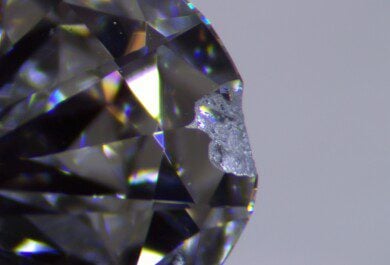With grateful acknowledgment to John Pollard, Sergey Sivovolenko, AGSL and GIA Laboratories for valuable resources and input. Graphics produced with DiamCalc software by OctoNus.
Note: This article pertains only to ‘superideal’ diamonds, meaning those with commonly agreed ‘ideal’ proportions and a high level of optical symmetry. Our understanding is that this diamond category makes up less than 1% of all round brilliant diamonds produced. The effects can be quite different on deeper and shallower diamonds.
Preface: Common Questions
Q: What are painting & digging?
A: They are approaches taken in final stages of polish, or brillianteering.
Painting shifts upper/lower girdle facets toward the mains so angles are closer together. The result is that average girdle thickness where the half junctions meet is greater than average thickness where the mains meet (diagram below).

Digging tilts upper/lower girdle facets away from mains so angles are farther apart. The result is that average girdle thickness where the half junctions meet is thinner than average thickness where the mains meet (diagram below).

For a more technical description refer to this GIA publication: http://www.diamondcut.gia.edu/pdf/6_05_RDR_pg239_243pdf.pdf
Q: Why Paint or Dig?
- To try and retain weight at critical points: If a diamond is close to a commercially important weight the painting approach may be used because less material is polished away. On the example below normal indexing would result in a finished diamond weighing 0.99 ct. Painting to 4 degrees – particularly on the pavilion’s long lower girdle facets – allows the commercially important 1.00 ct mark to be ‘saved.’

- To improve a verbal description of girdle thickness or clarity: For example, a very thick girdle may be dug out enough so that it will appear only ‘slightly thick’ to the grader, or an inclusion could be dug-out in order to improve the clarity grade.
- Relative to crown-only painting: To acquire desirable visual properties. A measure of crown-only painting on ‘superideal’ diamonds can improve the diamond’s brightness and increase the amount of visible broadfire dispersion.
Q: Why is it said that Painting & Digging are bad?
A: Because the most common uses of painting & digging are ‘swindling strategies’ in answers 1 and 2, above. What is not commonly known is that a measure of crown-only painting on superideal makes can be used to acquire desirable visual properties. Remember that the ‘superideal’ category of diamonds makes up less than 1% of all round diamonds produced.
The purpose of this article is to illustrate the differences between crown-only painting (which can be positive) and pavilion painting or digging of any kind (which are negative).
Painting and Digging Performance Comparisons
Painting & Digging Categories
Painting and Digging can be divided into several categories. For purposes of this article we will discuss the following three primary combinations (others follow in our appendices).
1A. Crown-Only Painting
1B. Crown-Only Digging
2A. Pavilion-Only Painting
2B. Pavilion-Only Digging
3A. Crown & Pavilion Painting
3B. Crown & Pavilion Digging
Measuring Painting & Digging
Painting and digging will be measured in terms of degrees of average deviation from azimuth, or normal indexing. On a standard round brilliant 11.25 degrees (or less depending on configuration) is maximum.
ACP = Average Crown Painting. APP = Average Pavilion Painting
ACD = Average Crown Digging. APD = Average Pavilion Digging
Note: Painting & Digging can also be measured in ‘clicks’ which correspond to a diamond cutter’s tang. 1 click is equivalent to 3.75 degrees. 3 clicks, or 11.25 degrees, is maximum.
ASET Comparison Chart (generated using DiamCalc software by OctoNus)
We believe this charts supports the considerable difference we have observed between crown-only painting (1A) and all other painting & digging categories.
See this link for an explanation of ASET.
1A. Crown-Only Painting: No reduction in performance under the table. Gradual impact occurs along the girdle. In our experience the effects are not visible until ACP of 6-7° degrees (increased greens). The extent to which they are visible depends on overall configuration & optical symmetry. *Note that this applies to “superideal” diamonds with no pavilion painting or digging.
1B. Crown-Only Digging: In our experience reduction in performance begins with ACD >= 3°. Girdle facets fall off in performance especially fast (severe greens).
2A. Pavilion-Only Painting: Visible effects are notable with APP >= 3° (increased greens) and significant darkness under the table appears with APP >= 7° (severe blues).
2B. Pavilion-Only Digging: Reduction in performance under the table with APD >= 2° (severe blues). Girdle facets fall off in performance especially fast (severe greens).
3A. Crown & Pavilion Painting:
In our experience visible effects are notable with ACP+APP >= 4° (increased greens). Significant darkness under the table appears with >= 7° (severe blues).
3B. Crown & Pavilion Digging: Reduction in performance under the table with ACD+APD >= 2° (severe blues). Girdle facets fall off especially fast (severe greens).

Other combination charts appear in Appendices.
Crown-Only Painting – Actual Photos These 6 subject diamonds have crown-only painting. They range in ACP from 0.5–6.7 degrees.
Their pavilions have negligible deviations; all less than 0.5 degrees.
All 6 have premium ‘ideal,’ near-Tolkowsky proportions.
Ranges: D 60.4-61.6, T 54.1-56.9, C 34.6-34.9, P 40.6-40.9, S 50-55, LH 75-78
All 6 display high levels of optical symmetry or ‘Hearts and Arrows,’ assessed as ‘true’ or ‘near-true’ by standards published at this link.
All 6 range in size from 0.71 – 0.76 ct. Their color and clarity range from E-G and SI1-SI2 (with the exception of subject 4 which is I VVS1) on grading documents from the AGS and GIA.
Note: Because of the difficulties inherent in photographing fine distinctions in appearance aspects, the images shown in Photos 1 and 2 may not perfectly match what is seen when the actual diamonds are viewed face up.
Photo 1: Fluorescent lighting, white background. (L-R: ACP 0.5°, 1.5°, 3.3°, 4.0°, 6.2°, 6.8°)

Photo 2: Fluorescent lighting, black background. (L-R: ACP 0.5°, 1.5°, 3.3°, 4.0°, 6.2°, 6.8°)

Photo Compilation 3: Corresponding Ideal-Scope images

Photo Compilation 4: Corresponding ASET images


Crown-Only Painting – Assessment (AGS, GIA, OctoNus)
The AGS performs ray-tracing analysis on each diamond it cut-grades. A diamond of any configuration must return specific numeric values for brightness, dispersion, leakage and contrast to earn the top grade. Painting & digging judgments are incorporated into the overall face-up performance assessment.
The GIA scans each diamond and uses the reported proportions to determine cut grade. Metrics obtained from the girdle scan are used to establish a painting & digging value. The same brillianteering judgments are applied to all configurations.
The OctoNus Helium scanner is an extremely accurate scanning device. OctoNus has developed a chart with verbal descriptions for degrees of painting or digging, found at this link.
Here is how the 6 subject diamonds would be assessed in these systems (OctoNus verbal descriptors are being adjusted at the time of publication – this article will be edited to reflect those changes):
Diamond #1. ACP 0.5 degrees: AGS 0 Ideal, GIA EX, OctoNus Negligible
Diamond #2. ACP 1.5 degrees: AGS 0 Ideal, GIA EX, OctoNus Small
Diamond #3, ACP 3.3 degrees: AGS 0 Ideal, GIA EX, OctoNus Moderate
Diamond #4, ACP 4.0 degrees: AGS 0 Ideal, GIA EX, OctoNus Moderate
Diamond #5, ACP 6.2 degrees: AGS 0 Ideal, GIA VG, OctoNus Large
Diamond #6, ACP 6.8 degrees: AGS 1, GIA VG, OctoNus Large
With these configurations:
Beyond 7.0 degrees would be AGS 1-2, GIA G. OctoNus describes as Very Large
Beyond 8.2 degrees would be AGS 2, GIA G, OctoNus describes as Maximum
Notes
- Subject diamonds #1, #2, #3 and #4 receive the top cut grade from both AGS and GIA.
- Subject diamond #5 earns numeric values for 0 ‘Ideal’ light performance when ray-traced by AGS. GIA reduces it by one grade based on the girdle scan.
- Subject diamond #6 earns numeric values for 1 in light performance when ray-traced by AGS. GIA reduces it by one grade based on the girdle scan.
Summary
Even moderate pavilion painting (2A, 3A) and digging anywhere on the diamond (1B, 2B, 2C) should be downgraded. However, crown-only painting (1A) should be treated differently, as it does not reduce performance until extremes and can be used to positively enhance optical properties. This agrees with the American Gem Society’s diamond-specific ray-tracing research, studies at Moscow State University and independent leaders in the field of optics.
To this end, we believe crown-only painting should be independent of other painting/digging judgments.
I hope this article allows others to understand that the stereotyping of ‘painting’ or ‘digging’ is erroneous when the diamond is not in-hand. To make decisive evaluations one must know the diamond’s configuration, what type of painting or digging was done, and to what degree. To speculate or stereotype will lead to invalid conclusions.
This study reinforces my assertion that the pavilion of the diamond is of prime importance. I have always maintained that “it’s all in the hearts:” Precise, symmetrical pavilion construction at normal indexing is the foundation for premium performance and has been since long before we had wonderful tools like DiamCalc and ASET which are scientifically reinforcing my long-standing position, learned over five generations of experience and research.
Appendix A: More Comparison Charts
Look from left to right and top to bottom to make relative comparisons.
Example: Comparison Chart 2. Crown & Pavilion Both Painted
With 0° pavilion painting there is negligible difference as the crown is painted to 6°.
With 1° pavilion painting the re are blues under the table and slight increases in green out to 6°.
With 3° pavilion painting there is less blue and more green at the girdle out to 6°.
With 5° pavilion painting there is even less blue and even more green out to 6°.



Appendix B: Wire-Frame Girdle Profiles
p align=”center”>These illustrations show relative degrees of painting & digging as seen in the girdle profile.






Appendix C. Performance Comparisons
0. Normal Indexing : Values nominal


1A. Crown-Only Painting to 6° : Values Nominal


1A. Crown-Only Digging to 6° : Reduction in light return


2A. Pavilion-Only Painting to 6° : Major Reduction in contrast


2B. Pavilion-Only Digging to 6° : Reduction in light return


3A. Crown & Pavilion Painting 6° : Major reduction in contrast


3B. Crown & Pavilion Digging to 5° : Severe reduction in light return


Crown & Pavilion Digging to 11° : Reduction in light return. Severe reduction in contrast.


Crown Painted to 11°, Pavilion Dug to 11° : Major reductions in light return and Contrast.


Crown Dug to 11°, Pavilion Painted to 11° : Major reductions in light return and Contrast.


Appendix D. Enlarged ASET Comparisons
1A. Crown-Only Painting: No reduction in performance occurs under the table. There is gradual impact along the girdle but this is not visible until 6-7° degrees occurs (increased greens).

1B. Crown-Only Digging: Reduction in performance begins when digging to 3°. Girdle facets fall off in performance especially fast (severe greens).

2A. Pavilion-Only Painting: Visible effects are notable once 4° is passed (increased greens) and significant darkness under the table appears after 7° (severe blues).

2B. Pavilion-Only Digging: Reduction in performance under the table even at 2° (severe blues). Girdle facets fall off in performance especially fast (severe greens).

3A. Crown & Pavilion Painting: The visible effects are notable once 4° is passed (increased greens) and significant darkness under the table appears after 7° (severe blues).

3B. Crown & Pavilion Digging: Reduction in performance under the table even at 2° (severe blues). Girdle facets fall off especially fast (severe greens).

by Whiteflash.com

























































